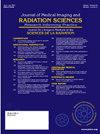Comparative study of image quality between T2-weighted FRFSE and PROPELLER based on respiratory patterns of abdominal MRI
IF 1.3
Q3 RADIOLOGY, NUCLEAR MEDICINE & MEDICAL IMAGING
Journal of Medical Imaging and Radiation Sciences
Pub Date : 2024-10-01
DOI:10.1016/j.jmir.2024.101513
引用次数: 0
Abstract
Purpose
To evaluate and analyze the image quality of the T2W propeller technique according to breathing patterns by comparing and analyzing the propeller / blade techniques during abdominal MRI examinations.
Subjects and Methods
A total of 238 patients (141 males:97 females) undergoing abdominal MRI examinations were analyzed. The equipment was GETM Signa Hdxt 1.5T, the coil was 12ch Body Array, and Axial T2W FRFSE (Fast Recovery FSE) and Axial T2W PROPELLER examination techniques were performed. The groups were divided into 4 groups (A: more than 18 breaths, B: 13∼17 breaths, C: less than 12 breaths, D: inconsistent breathing) according to breathing patterns. The images were quantitatively evaluated using SNR, CNR, and NRQA (non-referenced quality assessment), and qualitatively evaluated by two abdominal radiologists using a 5-point Likert scale. The results were statistically analyzed using R-Studio 4.3.1.
Results
In both quantitative evaluation (SNR, CNR, BRISQUE) and qualitative evaluation, the quality of Axial T2W FRFSE images in groups B and C was better (p<0.001*), and Axial T2W PROPELLER images in groups A and D were better (p<0.05*). However, there was no significant difference in SNR of group A among quantitative evaluation items and Ghost Artifact of group C among qualitative evaluation items.
Conclusion
In abdominal MRI examinations, the PROPELLER technique showed differences in image quality depending on the breathing method. It was found that the image quality of the PROPELLER technique was better only when the breathing rate was not fast or consistent for more than 18 breaths. Therefore, it is effective to use the PROPELLER technique appropriately according to the patient's breathing method during abdominal MRI examination.
基于腹部磁共振成像呼吸模式的 T2 加权 FRFSE 和 PROPELLER 图像质量比较研究
目的通过比较和分析腹部磁共振成像检查中的螺旋桨/叶片技术,根据呼吸模式评估和分析 T2W 螺旋桨技术的图像质量。设备为 GETM Signa Hdxt 1.5T,线圈为 12ch 体阵,采用轴向 T2W FRFSE(快速恢复 FSE)和轴向 T2W PROPELLER 检查技术。根据呼吸模式将患者分为 4 组(A:18 次以上呼吸;B:13∼17 次呼吸;C:少于 12 次呼吸;D:呼吸不连贯)。图像采用信噪比(SNR)、有线信噪比(CNR)和无参考质量评估(NRQA)进行定量评估,并由两名腹部放射科医生采用 5 点李克特量表进行定性评估。结果在定量评价(SNR、CNR、BRISQUE)和定性评价中,B 组和 C 组的轴向 T2W FRFSE 图像质量更好(p<0.001*),A 组和 D 组的轴向 T2W PROPELLER 图像质量更好(p<0.05*)。结论在腹部 MRI 检查中,PROPELLER 技术的图像质量因呼吸方式的不同而存在差异。研究发现,只有当呼吸频率不快或持续超过 18 次呼吸时,PROPELLER 技术的图像质量才较好。因此,在腹部磁共振成像检查中,根据患者的呼吸方式适当使用 PROPELLER 技术是有效的。
本文章由计算机程序翻译,如有差异,请以英文原文为准。
求助全文
约1分钟内获得全文
求助全文
来源期刊

Journal of Medical Imaging and Radiation Sciences
RADIOLOGY, NUCLEAR MEDICINE & MEDICAL IMAGING-
CiteScore
2.30
自引率
11.10%
发文量
231
审稿时长
53 days
期刊介绍:
Journal of Medical Imaging and Radiation Sciences is the official peer-reviewed journal of the Canadian Association of Medical Radiation Technologists. This journal is published four times a year and is circulated to approximately 11,000 medical radiation technologists, libraries and radiology departments throughout Canada, the United States and overseas. The Journal publishes articles on recent research, new technology and techniques, professional practices, technologists viewpoints as well as relevant book reviews.
 求助内容:
求助内容: 应助结果提醒方式:
应助结果提醒方式:


